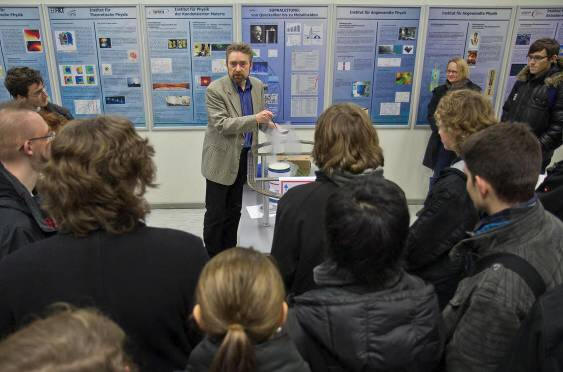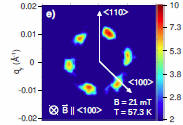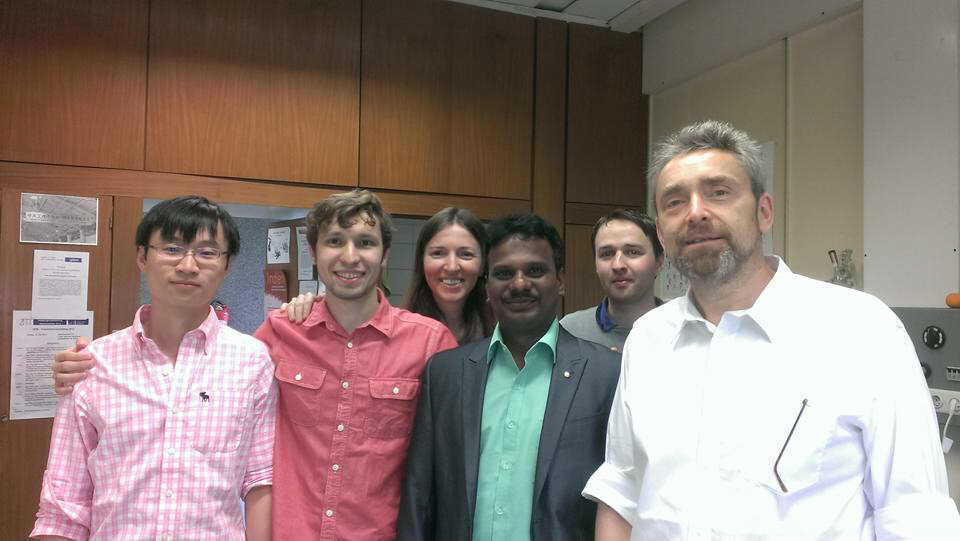 |
1.6. und 30.6.2014: Evaluationen der VL
Festkörperphysik
und
Nanotechnologie
|
 |
12.05.2014:
NANOMET - We are a member of the newly founded RTG
Graduate School of the DFG,
Metrology of Complex
Nanosystems, jointly with the PTB
|
 |
05.05.2014: We congratulate Kwang-Yong Choi for his
AvH-Fellowship to be spend in our group on
Correlation
effects in Topological Insulators
|
 |
11.04.2014: The Lower Saxonian
Graduation program, Interactions, Control and Quantum
Dynamics starts
|
 |
08.04.2014:
Laboratory for Emerging
Nanometrology and Analytics starts
|
 |
18.01.2014: Infotag - Supraleitung, Elektronenpaare
durch Dick und Dünn.
|
 |

|
 |
17.1.2014: Jazz-Downtown at the Vielharmonie
|
 |
05.12.2013:
Seminar at the Texas Center for Superconductivity
TcSUH
|
 |
23.07.2013:
Superconductivity and Iron, lecture at the ZFM-Hannover
Summerschool
on Functional Solids, Goslar
|
 |
19.07.2013:
Participation in
"MOOC's
at the TU Braunschweig"
|
 |
16.01.2013:
Participation in the course "Lectures
in a mobilizing way", Kompetenzzentrum Hochschuldidaktik Niedersachsen.
|
 |

|
16.04.2013:
The nanoworld at your fingertips, with our
new Plasma-enhanced Atomic Layer Deposition (ALD)
we prepare novel metamaterials and devices.
Project together with A.
Waag and
A. Bakin from IHT,
TU-BS.
 |
26.1.2012: Physik - Schülerinformationstag und
Exkursion mit dem Physik III Kurs ins Phaeno, 13.1.2012
|
 |
 
|
Wir
danken Herr O. Stadel, Fa. Percotech
und Fraunhofer IST, für den Demonstrator "Supraleitung in der
Energietechnik", Photo: G. Dornig, EMG TU-BS.
 |
Congratulations to successful
phd defences.
a) Dirk Wulferding, 05.07.2013,
b) Hongdan Yan,
7.8.2012 (Pict. by G. Dornig), c) Fatih Cetin, 18.10.2012 (Pict.
by G. Dornig), d) Aidin Lak, 10.10.2013.
|
 |
  
|
 |

|
 |
Participants of the 27th Jazz and Rock Workshop in Salzgitter
enjoy their music onstage (7.-10.6.2011).
|
 |

|
|
Recent results: |
 |
There is a crossover from coherent to
incoherent excitations in a Mott insulator with
strong spin-orbit
coupling. We demonstrate this effect as function of the excitation energy of
the experiment. The modes of the J_eff=1/2 isospin
states in Sr2IrO4 leads to characteristic resonances
at the charge transfer energy, (Phys.
Rev. B). |
|
 |
Editors Choice... Evidence for a
Z2 quantum phase transition from a dimer to a resonating
valence bond state driven by singlet fluctuations. The rich
spectrum of singlet bound modes is attributed to a melting
of a dimer crystal, see
Phys. Rev. Lett. 110 (2013).
|
|
 |
Surface engineering of various nanoparticles (NPs) is of growing interest and an important
step to induce/control optical and/or catalytic activities.
Here we report a top-down fabrication methodology to
modify a model ferrofluid with parent NPs sizes ∼23 nm.
The surface engineering involves “ligand exchange”
and simultaneous “phase transfer”, and“core
etching”, resulting in a reduction of particle diameter to
∼5 nm. We have used the functionalized NPs for the photodegradation of biomedically important jaundice marker bilirubin in aqueous solution. Overall, the results
represent a promising route for the fabrication of NPs
adaptable to diverse applications, see
Journ. of Phys. Chem. C (2014). |
|
 |
Charge migration along DNA molecules is a key factor for
DNA-based devices in optoelectronics and biotechnology.
We have investigated the role
of water molecules in DNA-based
materials for the intactness of the DNA structure and
their dynamic role in the charge-transfer (CT) dynamics.
This study uses time resolved optical spectroscopy and is
based on a collaboration between groups from Kolkata, Idia
and the TU-Braunschweig,
see
Chemistry, An Asian Journal (2014). |
|
 |
In the giant Rashba
system BiTeI as well as in topological insulator there exist
an enhanced
quasiparticle dynamics of quantum well states.
This is due to a time dependent band beneding leading to a
surface confined quantum well state. Topological insulators
and Giant Rashba system share a very similar surface
chemistry and strong spin orbit coupling of bulk and surface
states. However, they have a different symmetry in the bulk.
This leads to a different symmetry of electronic Raman
scattering, see
PRB.
|
|
 |
A novel
solid
solution (Co1-xNix)3Sb4O6F6
with a pseudo
kagome structure can be taylored with
respect to its physical properties by changing its
composition. This systems can be used to better understand
the interplay of dimensionality, anisotroy
and magnetism within one crystallographic structure.
This is a collaboration between groups from Stockholm,
Houston and Braunschweig,
see
Chem. of Mat., (2014). |
  |
The novel oxofluoride
Cu7(TeO3)6F2
shows features of
both zero and one dimensional magnetism.
This is due to an interplay of composition that contains
fluorine ions as well as the lone pair element Te with the
electronic configuration of the Cu 3d
orbitals.
In contrast to many other compounds the fluorine terminates
the magnetic exchange path. Te with its lone pair electrons
opens up the structure like a scissor. The alternation of
different Cu orbitals (see right figure) has a further
important consequence for the exchange from one Cu2 sites
(brown plaquette) to the other. As a result low energy
fluctuations exist in a broad temperature range. This is a
collaboration between groups from Stockholm, Houston and
Braunschweig, see
Inorganic
Chemistry, (2014). |
 |
Dynamic lattice distortion and spin
fluctuation cooperate in the spin liquid phase of a low-dimensional compound nitrosonium nitratocuprate.
This system has been proposed to be a model compound for the
resonanting valence
bond ground state (RVB).
Our data, however, point towards a structural instability at
low temperatures that freezes out spin correlations by an
excitation gap
(Phys. Rev. B 85, (2012)
and
cond-mat). |
|
 |
The magnetoelectric compound
Cu2OSeO3
shows a state with an inhomogenous spin polarization called
SKYRMION phase. These objects are
topologically protected
and form a
superstructure that can be investigated by small angle
neutron scattering. The skyrmion phase in an insulator with
coupled dielectric-spin degrees of freedom allows new
applications in the field of spintronics
(Phys.
Rev. Lett). |
 |
Frustrated quantum spins realized by
transition metal ions in solids form states of matter with
novel properties. We show how a modification of the chemical
composition in zinc paratacamite can be used to tailor its
magnetic properties from a spin liquid to a spin glas
(Phys.
Rev. B
and
cond-mat). |
 |
Molecules that consist of
three Cu ions and are arranged in
a lattice (freestanding porous silicon) realize a novel
hybrid material. It
provides a promising scheme for implementing spin-based
quantum gates. By measuring the spin relaxation times of
samples with different symmetries and
environments we give evidence that a spin chirality is the
main decoherence source of spin triangle
molecules (Phys.
Rev. Lett.).
|
 |
Topological insulators allow collision
dominated scattering with spin-helical symmetry. This
scattering is due to fluctuations from Dirac to bulk states
of the compound despite topological protection. The
scattering rate is determined from the position of a maximum
in the RL scattering component as
G=40cm-1
(Phys.
Rev. B). |
| |
|
|

|
Magnetic
molecules can be tuned by a confinement in the nanocage of a Protein,
(Chem
Phys Chem). |
|
|


Diese
Web-Seite stellt keine Meinungsäußerung der TU Braunschweig dar.
p.lemmens at tu-bs.de,
letzte Änderung: 29.09.2018
|
|
|
















